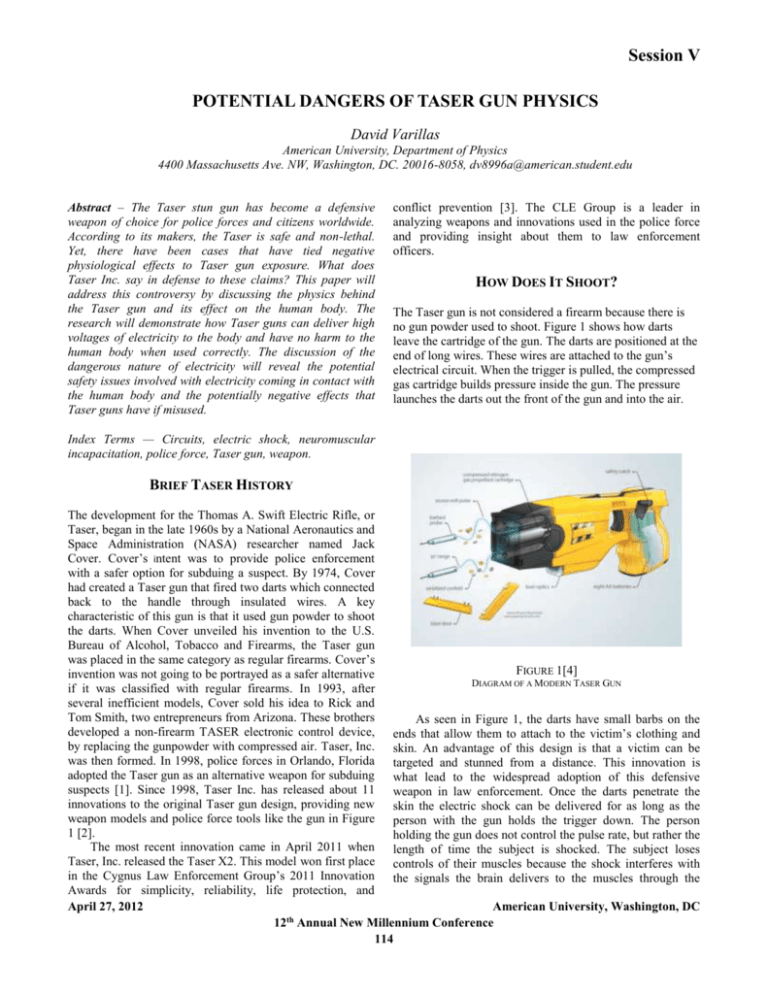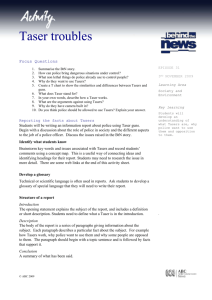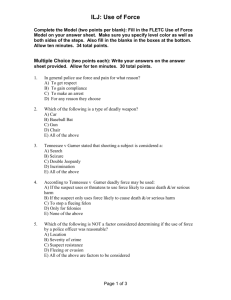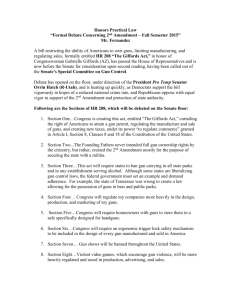
Session V
POTENTIAL DANGERS OF TASER GUN PHYSICS
David Varillas
American University, Department of Physics
4400 Massachusetts Ave. NW, Washington, DC. 20016-8058, dv8996a@american.student.edu
Abstract – The Taser stun gun has become a defensive
weapon of choice for police forces and citizens worldwide.
According to its makers, the Taser is safe and non-lethal.
Yet, there have been cases that have tied negative
physiological effects to Taser gun exposure. What does
Taser Inc. say in defense to these claims? This paper will
address this controversy by discussing the physics behind
the Taser gun and its effect on the human body. The
research will demonstrate how Taser guns can deliver high
voltages of electricity to the body and have no harm to the
human body when used correctly. The discussion of the
dangerous nature of electricity will reveal the potential
safety issues involved with electricity coming in contact with
the human body and the potentially negative effects that
Taser guns have if misused.
conflict prevention [3]. The CLE Group is a leader in
analyzing weapons and innovations used in the police force
and providing insight about them to law enforcement
officers.
HOW DOES IT SHOOT?
The Taser gun is not considered a firearm because there is
no gun powder used to shoot. Figure 1 shows how darts
leave the cartridge of the gun. The darts are positioned at the
end of long wires. These wires are attached to the gun’s
electrical circuit. When the trigger is pulled, the compressed
gas cartridge builds pressure inside the gun. The pressure
launches the darts out the front of the gun and into the air.
Index Terms — Circuits, electric shock, neuromuscular
incapacitation, police force, Taser gun, weapon.
BRIEF TASER HISTORY
The development for the Thomas A. Swift Electric Rifle, or
Taser, began in the late 1960s by a National Aeronautics and
Space Administration (NASA) researcher named Jack
Cover. Cover’s intent was to provide police enforcement
with a safer option for subduing a suspect. By 1974, Cover
had created a Taser gun that fired two darts which connected
back to the handle through insulated wires. A key
characteristic of this gun is that it used gun powder to shoot
the darts. When Cover unveiled his invention to the U.S.
Bureau of Alcohol, Tobacco and Firearms, the Taser gun
was placed in the same category as regular firearms. Cover’s
FIGURE 1[4]
invention was not going to be portrayed as a safer alternative
DIAGRAM OF A MODERN TASER GUN
if it was classified with regular firearms. In 1993, after
several inefficient models, Cover sold his idea to Rick and
Tom Smith, two entrepreneurs from Arizona. These brothers
As seen in Figure 1, the darts have small barbs on the
developed a non-firearm TASER electronic control device, ends that allow them to attach to the victim’s clothing and
by replacing the gunpowder with compressed air. Taser, Inc. skin. An advantage of this design is that a victim can be
was then formed. In 1998, police forces in Orlando, Florida targeted and stunned from a distance. This innovation is
adopted the Taser gun as an alternative weapon for subduing what lead to the widespread adoption of this defensive
suspects [1]. Since 1998, Taser Inc. has released about 11 weapon in law enforcement. Once the darts penetrate the
innovations to the original Taser gun design, providing new skin the electric shock can be delivered for as long as the
weapon models and police force tools like the gun in Figure person with the gun holds the trigger down. The person
1 [2].
holding the gun does not control the pulse rate, but rather the
The most recent innovation came in April 2011 when length of time the subject is shocked. The subject loses
Taser, Inc. released the Taser X2. This model won first place controls of their muscles because the shock interferes with
in the Cygnus Law Enforcement Group’s 2011 Innovation the signals the brain delivers to the muscles through the
Awards for simplicity, reliability, life protection, and
April 27, 2012
American University, Washington, DC
12th Annual New Millennium Conference
114
Session V
nervous system.
There is a lot of physics involved in that seemingly
simple dart release. Understanding electricity is key in
knowing how Taser guns use that electric shock.
PHYSICS OF ELECTRICITY
At its core, electricity involves electric charges, forces,
fields, and the motion of all of these. An electric charge is a
property of matter that underlies all electrical activity. A
particle can have a positive or negative charge, meaning that
the particles of matter can possess more or less electrons.
Like charges are repelled when brought near each other and
opposites are attracted. Electricity is the flowing of these
electric charges. These flowing charges create a current of
electricity, similar to that of flowing water. Much like water
needs a hose in order to flow from one place to another,
electricity needs a medium. Electricity must have a
conductor in order to flow. A conductor can be any medium
that allows the motion of electric charges through it. Metals
are very good conductors because of their atomic structure.
Some electrons in the atoms of metals are “free” and so
electron flow is loose. To measure how fast an electrical
charge is flowing, we must look at the charge over time.
Equation (1) shows how to measure the speed of a current.
I
q
t
(1)
In the equation above, I is the electric current measured
in Amperes, q is the electric charge in Coulombs, and t is the
time measured in seconds. The amperage of an electrical
current is the electric charge per time [5]. Amperes are volts
per ohm [6].
The joules of energy that one moves along a path, or the
energy a particle possesses by virtue of its location, is called
electric potential energy. When these particles are moved,
charge is required. That is why it is convenient to deal with
electric potential energy per unit charge. Charge is measured
in Coulombs. Therefore we measure electric potential
energy, in joules, per unit charge, in Coulombs. There is a
special name for this concept and it is called electric
potential, or voltage. Voltage is the joules of energy that one
moves along a path divided by the Coulombs of charge.
High voltage is only dangerous when there is a lot of
charge present. For example, there are approximately 110
volts in those wall outlets in our homes. Being exposed to
this voltage in our sockets can be very dangerous because
there is a high level of charge. Being exposed to extreme
levels of voltage at low charges isn’t as dangerous. An
example of little danger with high voltage and little charge is
the voltage across a balloon that has been charged by
rubbing it against one’s head. Touching the balloon is
harmless because despite the high electric potential, very
little charge is involved, thus producing very little energy
April 27, 2012
transfer. Current depends not only on the voltage, but also
on the amount of resistance the conducting materials have.
Electrical resistance is measured in ohms. George Simon
Ohm discovered the relationship between current, voltage,
and electrical resistance. [7] These properties lay the basis
for creating electrical circuits.
CREATING CIRCUITS
A circuit is simply a path in which electrons can flow.
Circuits must be closed in order for the flow to be
continuous, meaning that there cannot be any gaps in the
circuit. When an electrical circuit is created with the human
body, electrons are flowing right through the body. This is
what is called an electric shock. The pain, and potential
damage, of an electric shock depends on the current in
amperes [8]. Ohm’s law states that the current in amperes is
equal to the voltage divided by the resistance. A
rearrangement of Ohm’s law states:
V IR
(2)
Equation 2 is a simple rearrangement of Ohm’s law and
it states that the voltage, V, is equal to the current, I,
multiplied by the resistance, R. This means that current and
voltage are proportional to each other. A higher current
means a higher voltage. The electric shock’s effects depend
on both the voltage applied and the resistance of the body.
The resistance of one’s body varies and depends on
conditions such as dryness. If one’s skin is very dry,
resistance can reach up to 500,000 ohms, as opposed to a
mere 100 ohms when one is soaked in water. This explains
why a tongue tingles when placed on the terminals of a 9V
battery. One’s dry fingers don’t feel that tingle when they
are placed over the same terminals. Taser guns work under
the same rules. The strength of an electric shock delivered
on a suspect depends highly on the voltage across the bodily
circuit, the current delivered by the gun, and the resistance
of the body.
ELECTRIC SHOCK AND TASER GUNS
The Taser stun gun delivers an electric current—and thus, an
electric shock—to the body of an individual, disrupting the
control of his muscles. The term electric shock is used
whenever electricity flows through a body. The Taser
releases two pointed darts that penetrate the skin when fired.
These darts are connected to the cartridge in the officer’s
hand, for example. These darts create a potential energy of
5,000+ volts through the body of individual. However, the
amperage of the current is only about .003 amps. Thus,
according to Ohm’s law, the shock delivered is not
completely dangerous.
American University, Washington, DC
12th Annual New Millennium Conference
115
Session V
In Table 1, different amperages are compared to show
their different effects on the body.
TABLE 1[9]
EFFECTS OF DIFFERENT AMPERES ON THE HUMAN BODY; CREDIT TO PAUL
HEWITT
Current (Amperes)
Effect
.001
Can be felt
.005
Is painful
.010
Causes involuntary muscle
contractions spasms
.015
Causes loss of muscle control
.070
If through the heart, causes serious
disruption; probably fatal if
current last for more than 1
second.
A Taser gun’s current measures approximately .015
Amperes, meaning that the current is strong enough to cause
muscle incapacitation. The electric shock that the Taser gun
gives the human body isn’t continuous. The current is
delivered in pulses. If one stands under a rain storm, one can
see and feel the low force of the rain despite the high vertical
distance it traveled. Because the rain traveled a long distance
before hitting one’s body, it possesses a high “voltage,” per
se. However, this high “voltage” does not hurt you because
the “current” of the rain is low. The rain’s “current” comes
in individual raindrops separated by space and time.
Standing under rainfall is similar to being exposed to a Taser
gun in the sense that there is a high voltage being delivered
to your body, but in the form of a low and pulsed current.
One can compare the difference in dangers between
regular wall outlets in a home with Taser guns.
When one is to examine the danger of an electric circuit,
voltage cannot be the only aspect considered. High voltage
does not necessarily mean greater danger. Similarly, low
voltage does not necessarily connote low danger. The danger
of the current is determined by the voltage and the
amperage. For example, a wall outlet in a typical home
delivers 110 volts. However, the outlet pumps many
amperes of current continuously, making the relatively low
voltage very dangerous [11]. Moreover, a shock resulting
from contact with a doorknob on a very dry day can deliver
a 25,000 Volt shock, yet it won’t cause fatal injuries because
of the low amperage. Much like a charged balloon with a
very high voltage across its length, the high voltage across
the current delivered by a Taser gun releases little energy
because the of the current’s low amperage.
FIGURE 3 [12]
DEMONSTRATION OF TASER INCAPACITATING SUBJECT’S MUSCLE
CONTROL
When the darts of a Taser gun penetrate an individual’s
skin, as in Figure 3, a circuit is created [13]. The high
voltage combined with the low amperes of current provides
a shock that is strong enough to incapacitate the muscles.
IMMEDIATE PHYSICAL EFFECTS:
NEUROMUSCULAR INCAPACITATION
In order for muscles to move, they must receive
communication from the brain through nerves. This
communication between the nerves in the brain and the
muscles is the basis of the neuromuscular system [14]. If one
willingly wants to move part a body part, a message from
the brain is sent to that body part’s nerve cells, or neurons.
These neurons are called upper motor neurons, as shown in
figure 4 [15].
FIGURE 2 [10]
COMPARING A WALL OUTLET SHOCK TO A TASER SHOCK
April 27, 2012
American University, Washington, DC
12th Annual New Millennium Conference
116
Session V
metabolic acidosis.
METABOLIC ACIDOSIS
FIGURE 4 [16]
ILLUSTRATION SHOWING MOTOR NEURON CONNECTING TO MUSCLE
FIBER
The Taser gun’s pulsed current mimics the nerve signals
sent through the neurons that control muscle movement [17].
The pulsed current then simulates the brain waves within the
nerves and interferes with the communication between the
brain and the muscles, causing the muscles to freeze.
Metabolic acidosis occurs when the level of lactic acid in the
blood increases [20]. When the energy stored in the Taser
gun is released into the body of the victim, the shock
depletes the sugar levels in the victim’s blood and converts it
to lactic acid [21]. Taser gun exposure can cause strong
muscle contractions, which causes increased production of
lactic acid. [22] The production of lactic acid decreases the
blood’s pH level, causing a risk of injury.
While being shocked by Taser guns does increase lactic
acid in the blood, studies have shown that there is no
clinically significant increase in a 15 second exposure
window [23]. A study performed by the Department of
Emergency Medicine at the State University of New York at
Buffalo examined the effects of prolonged continuous Taser
gun exposure on alcohol intoxicated individuals [24]. Adults
were given mixed alcoholic drinks until they reached clinical
intoxication levels. The pH levels of the same individuals
were recorded before drinking, immediately after drinking,
immediately after a 15 second exposure to a Taser gun, and
24 hours after the alcohol ingestion and Taser gun shock
[25]. The study showed that pH levels decreased and lactate
acid production increased merely after the ingestion of
alcohol. This increase continued after the 15 second
exposure to the Taser gun shock. After 24 hours, the levels
returned to the levels at the beginning of the test [26]. The
study concluded that prolonged and continuous exposure to
Taser guns had an effect on its subjects, yet the increase in
lactic acid and decrease in pH levels were clinically
insignificant in terms of metabolic acidosis [27]. Acidosis is
merely one of the effects of electric shock in the body. There
is also a potential danger to breathing.
BREATHING
FIGURE 5 [18]
TASER GUN’S INTERFERENCE WITH THE NERVOUS SYSTEM
The lungs are controlled by muscles in the body, and
because Taser guns have the strength to incapacitate muscle
control, prolonged exposure to Taser gun electric shock
seems to be disrupting to normal breathing. Normal
breathing consists of inhalation and exhalation of air [28].
Inhalation, or breathing in, involves muscle contraction.
Muscles, such as the diaphragm, contract when one breaths
in. Exhalation, or breathing out, is the relaxation of those
same muscles [29].
Because Taser guns cause muscle contractions when in
contact with its subjects, it seems that it can potentially
freeze the lungs and prevent normal breathing. Some
speculate that respiratory acidosis can occur. Respiratory
acidosis is when carbon dioxide is not exhaled and causes
the blood pH to decrease or increase in acidity [30]. A study
performed by scientists at the University of Louisville in
2010 has found otherwise. The scientists exposed 53
The current delivered by the Taser gun strong enough to
incapacitate the muscles. When the darts apply current to the
victim for a ½ second, it will simply startle the assailant,
causing the victim some pain, muscle contractions, and
physical shock. After 1-2 seconds, the current will cause
muscle spasms and a confused mental state. After 3-5
seconds, the Taser will cause total loss of muscle control,
loss of balance, and a shocked mental state [19]. A
ramification of these effects is a metabolic response to the
shock. A prolonged shock from a Taser gun causes the blood
to become more acidic. This acidic response is called
April 27, 2012
American University, Washington, DC
12th Annual New Millennium Conference
117
Session V
subjects to 10 seconds of Taser gun shock and measured
vital signs before and after the shock. In the conclusion of
the study, the scientists claimed that there were no
significant changes in vital signs and electrolytes [31]. This
study’s results emphasized that there was no evidence of
impairment of breathing. These scientists simply studied the
lungs, but another vital muscle in the body that could also be
in danger is the heart.
CARDIAC EFFECTS
Critics of the Taser gun also point out that since the heart is
made up mostly of muscle, the muscular incapacitation
caused by the Taser gun can cause cardiac problems such as
ventricular fibrillation [32]. Ventricular fibrillation is when
the heart beats rapidly and erratically [33]. The ventricles in
the heart quiver erratically instead of pumping blood through
the heart [34]. During ventricular fibrillation, the body’s
organs do not receive enough blood because the heart isn’t
pumping effectively, producing fatal dangers such as heart
attacks [35]. Figure 6 shows how the ventricles quiver
without pumping out any blood, depleting the rest of the
body from its blood.
FIGURE 6 [36]
DIAGRAM OF VENTRICLES QUIVERING WITHOUT PUMPING BLOOD
A study conducted by a group of researches from the
Hennepin County Medical Center in Minnesota conducted a
study with Taser guns, examining its cardiovascular effects.
The scientists’ subjects underwent 10 seconds of exposure to
the Taser gun shock [37]. Electrocardiograms (ECGs) were
obtained before and after the shocks and they were used
throughout the whole exposure process to observe the
heart’s rhythm [38]. In one of the trials, there was a brief
April 27, 2012
“cardiac capture,” so the trial was immediately halted. The
subject’s heart stopped dangerously and so the trial was
halted. The Taser gun was then redesigned and the trials
continued. With the redesigned Taser gun, 45 subjects were
examined and there was no evidence of “cardiac capture”
[39]. The study group notified the manufacturers of the first
faulty Taser gun model, so Taser Inc. did not release it [40].
This study served as a warning that despite the Taser gun’s
general low risk, its technology could potentially be
dangerous.
TASER GUNS AND DEATH
RELATED INCIDENTS
Between 2003 and 2005, 48 states and Washington D.C.
have reported 1,095 arrest-related deaths [41]. Police forces
chose Taser guns in the first place because they offered a
less-lethal technology for subduing individuals [42].
Although arrest-related deaths and injuries were reduced
with the adoption of the Taser gun, there was still
speculation with its negative physiological effects. This
concern was brought to the U.S. Department of Justice. The
U.S. Dept. of Justice and its National Institute of Justice
(NIJ) branch gathered the most up-to-date research in order
to address the issue. The NIJ admits that very little is known
about the effects of Taser guns on population of people other
than healthy adults [43]. Additional research is needed in
order to conclude whether Taser guns are lethal with at-risk
individuals (ie. non-healthy adults, pregnant women) [44].
The NIJ concludes that although the use of Taser guns is not
risk-free, there is no current medical evidence that suggests
that a high risk of injury or death can be directly produced
by Taser guns [45].
Immediate effects of the Taser gun’s contact with the
body could include puncture wounds or burns caused by the
darts released. The darts can become potentially dangerous if
they come in contact with delicate parts of the body such as
the eyes, causing loss of vision. Other vulnerable areas that
require extreme care include the head, face, neck, genitals,
and female breast regions. Physical harm may also occur
indirectly. For example, exposing the Taser gun to someone
on a steep slope can cause injury and even death if the
individual results falling. Moreover, someone who is in
contact with water may result drowning, or someone near
flammable materials may suffer injury or death if a spark is
created by the device. The NIJ has not reported any of these
cases, but the possibility of them occurring is still present.
[46]
SUMMARY
Since the adoption of the Taser gun in the late 1990s, police
enforcement has concluded through the studies conducted
that Taser guns definitely reduced injuries to officers and
suspects [47]. The studies that are available are very limited,
American University, Washington, DC
12th Annual New Millennium Conference
118
Session V
especially the ones examining extended exposure in humans.
Taser Inc. continues to conduct research since more cases of
injury involving Taser guns. While reviewing the deaths of
those who were seemingly direct victims of the Taser gun,
police notice that many are associated with continuous or
repetitive shocks from the Taser gun. Thus, police concluded
that until the medical risks of repeated or continuous
exposure to Taser guns is certain, caution must be exercised
and circumstances in which repeated discharge of the Taser
gun seems required should be kept to a minimum [48].
REFERENCES
[1]
[2]
[3]
[4]
[5]
[6]
[7]
[8]
[9]
[10]
[11]
[12]
[13]
[14]
[15]
[16]
[17]
[18]
[19]
[20]
[21]
[22]
[23]
[24]
[25]
[26]
[27]
[28]
[29]
[30]
[31]
<http://www.taser.com/corporate-history>, Accessed March 02,
2012.
Ref. 1
<http://www.officer.com/article/10440937/cygnus-lawenforcement-groups-2011-innovation-awards>, Accessed March
03, 2012.
<www.jamesprovost.com>, Accessed March 28, 2012.
Hewitt, Paul G. Conceptual Physics, 10th ed. San Francisco:
Pearson Addison Wesley, 2006.
<http://www.taser.com/research-and-safety/how-a-taser-works>,
Accessed Feb. 15, 2012.
Ref. 5.
Ref. 5.
Ref. 5.
Ref. 1.
<http://www.beststungun.com/faq.html#how%20stun>,
Accessed March 02, 2012.
<http://www.topillustrations.com/_upload/portfolio/1289
49889116400917.jpg> Accessed March 27, 2012.
<http://www.slate.com/articles/news_and_politics/explainer/200
6/11/how_do_tasers_work.html>, Accessed Feb. 25, 2012.
Gardiner, Phillip F. Neuromuscular Aspects of Physical
Activity. Human Kinetics, 2001.
Ref. 14.
<http://www.intropsych.com/ch02_human_nervous_system/neur
ons.html>, Accessed March 28, 2012.
Ref. 1.
Ref. 1.
<http://www.taser.com/research-and-safety/science-andmedical/medical/acidosis-studies>, Accessed March 02, 2012.
<http://www.lawyersandsettlements.com/features/taser_death/tas
er-death-tasered-to-deaths-by-tasers-2.html>, Accessed March
03, 2012.
Ref. 20.
<http://www.taser.com/research-and-safety/science-andmedical/medical/acidosis-studies>, Accessed March 02, 2012.
Ref. 22.
Moscati, R, Ho JD, Dawes DM, Miner JR. “Physiological
effects of prolonged conducted electrical weapon discharge in
ethanol-intoxicated adults.” The American Journal of
Emergency Medicine. Vol. 28, No. #5., June 2010.
Ref. 24.
Ref. 24.
Ref. 24.
<http://www.taser.com/research-and-safety/science-andmedical/medical/breathing-studies>, Accessed March 02, 2012.
Ref. 28.
Ref. 28.
Dawes Dm, Ho JD, Reardon RF, Strote SR, Nelson RS, et al.
“The respiratory, metabolic, and neuroendocrine effects of a new
generation electronic control device”, Forensic Science
International, Vol 207, No #1., 15 April 2011, pp. 55-60.
April 27, 2012
[32]
[33]
[34]
[35]
[36]
[37]
[38]
[39]
[40]
[41]
[42]
[43]
[44]
[45]
[46]
[47]
[48]
Dawes Dm, Ho JD, Reardon RF, Strote SR, Nelson RS, et al.
“Human cardiovascular effects of a new generation conducted
electrical weapon”, Forensic Science International, Vol 204, No
#1., 30 January 2011, pp. 50-57.
<http://www.mayoclinic.com/health/ventricularfibrillation/DS01158>, Accessed March 01, 2012.
Ref. 33.
Ref. 33.
<http://www.mayoclinic.com/health/medical/IM02524>,
Accessed March 01, 2012.
Ref. 32.
Ref. 32.
Ref. 32.
Ref. 32.
U.S Dept. of Justice. Deaths Following Electro-Muscular
Disruption. June 2008.
Ref. 41.
Ref. 41.
Ref. 41.
Ref. 41.
Ref. 41.
Ref. 41.
Ref. 41.
American University, Washington, DC
12th Annual New Millennium Conference
119









